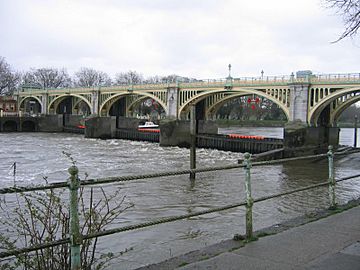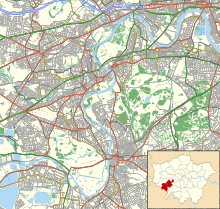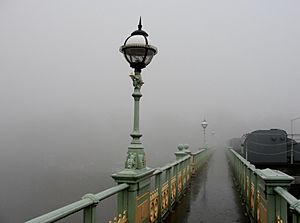Richmond Lock and Footbridge facts for kids

|
|
| Waterway | River Thames |
|---|---|
| County | Greater London |
| Maintained by | Port of London Authority |
| First built | 1894 |
| Length | 250 feet (76.2 m) |
| Width | 26 feet 8 inches (8.1 m) |
| Fall | Half tide lock (10 feet (3 m)) |
| Above sea level | 2 feet (0.61 m) (maximal low tide below lock) to greater than 20 feet (6.1 m) (usual maximal high tide above lock) |
| Coordinates | 51°27′44″N 0°19′02″W / 51.46222°N 0.31722°W |
|
Listed Building – Grade II
|
|
| Official name | Richmond Footbridge, Lock and Sluices |
| Designated | 25 May 1983 |
| Reference no. | 1250044 |
The Richmond Lock and Footbridge is a special structure on the River Thames in south west London, England. It includes a lock, which helps boats move between different water levels. It also has a low-tide barrier with controlled gates, and two pedestrian bridges for people to walk across.
This important structure is a Grade II* listed structure, meaning it's historically important. It's the last of the forty-five locks on the Thames as you head towards the sea. It's also the only one managed by the Port of London Authority. The lock and bridges opened in 1894.
You can find it north-west of Richmond town centre. On either side of the river downstream are famous places like Syon Park and Kew Gardens. The footbridge connects the promenade in Richmond with St. Margarets on the west bank. It's open during the day but closes at night for walkers.
At high tide, the large gates (called sluices) are lifted up. They hide behind metal arches that also form the two footbridges. This structure helps keep the water level high enough for boats upstream, even when the tide is low further down the river.
Contents
What is Richmond Lock?
Richmond Lock is a special kind of lock called a "half-tide lock." This means it works with the tides. For about two hours around high tide, the three huge sluice gates are lifted up. When they are up, boats can pass through the barrier easily without using the lock.
For the rest of the time, when the tide is lower, the gates are lowered. This creates a higher water level upstream. During these times, ships and boats must use the lock next to the barrier. There is a small fee for boats to use the lock. Smaller boats like rowing boats and kayaks can use special roller slipways to get past the barrier. The water level can change by up to 10 feet (3.0 m) at the lock.
Why Was It Built?
Before this lock was built, the River Thames at Richmond used to become very shallow at low tide. This happened after the old London Bridge was taken down in 1831. That old bridge used to act like a dam, keeping the water level higher upstream.
When the old bridge was removed, the tides could flow much more freely. This meant that for many hours each day, the Thames around Richmond would have large mud and shingle banks showing. It was hard for barges and other boats to travel. Also, more water was being taken from the river for London's water supply.
To fix this problem, people asked for a lock to be built for many years. Finally, in 1890, a law was passed to build the Richmond Footbridge, Sluice, Lock and Slipway. It was opened in 1894.
Who Designed and Built It?
The main engineer who designed the core parts of the lock was F.G.M. Stoney. He had many ideas for how to build the sluice gates. The lockhouses, where the lock keepers lived, were designed by Hunt and Steward. The metal parts, including the arches, were designed by Ransome and Rapier from Ipswich. The whole structure was built between 1891 and 1894.
How It Looks
The structure is built in three main parts. The first part is the lock itself. The middle part has the large sluice gates that can be raised or lowered. The last part has two ramps, some with rollers, for canoes and small boats.
The lock has four huge brick pillars on the north-east side. These pillars are very strong and support the metal arches above. These arches hold up the two walkways that form the footbridges. The pillars also contain the machinery for the sluice gates.
The bridge was officially opened on May 19, 1894, by the Duke of York, who later became King George V. It cost about £61,000 at the time.
Who Owns and Operates It?
When it was first built, the Thames Conservancy was in charge of Richmond Lock. Their goal was to keep the water deep enough for boats upstream. They made sure there was at least 1.72 metres (5 ft 8 in) of water in the main boat channel up to the next lock, Teddington Lock. Every year, the sluice gates are lifted completely to allow for dredging, which helps keep the channel deep.
In 1908, a new law changed things. Responsibility for this part of the river, including Richmond Lock, was given to the Port of London Authority. They have been in charge of it ever since.
Historic Details
In the past, the sluice gates were operated by hand by lock keepers. These lock keepers lived in houses that were built into the pedestrian steps and landings on both sides of the river.
From when the bridge opened until sometime during World War II, people had to pay a small fee to walk across the bridge. It cost one old penny. If you just walked onto the bridge and then left from the same side, it cost twopence. You can still see the old toll booths and where the turnstiles used to be.



